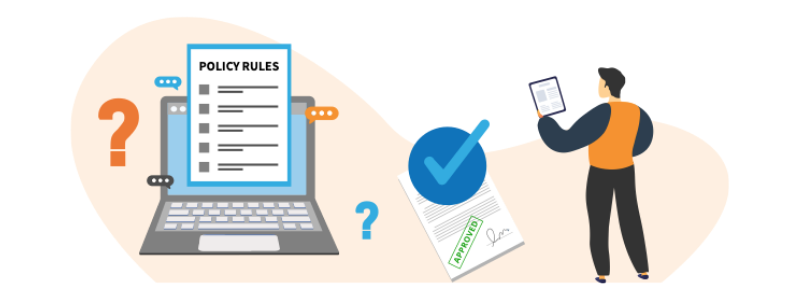Of all the HR policies, the leave policy grabs the maximum attention right from day one. Since employees go on leave all the time, your organization's leave policy is put to the test daily.
In this expert guide, all aspects of the leave policy design are explained. It also suggests best practices for the HR practitioner.
Table of Contents
- 1. What is a leave policy?
- 2. The Need for Leave Policy
- 3. Anatomy of a Leave Policy
- 4. Leave Types
- 5. Leave Rules
- 6. Weekend Policy
- 7. Holiday Lists
- 8. Key Ingredients of a Good Leave Policy
- 9. What is a Good Leave Policy?
What is a leave policy?
A leave policy is a document that lays down the rules and regulations related to various types of leaves that an employee can avail of.
A leave policy sets out the various types of leaves for different situations like a vacation, sickness, maternity, grief, etc. It specifies rules for various aspects like granting of leave, eligibility, availing, encashment, etc.
The leave policy reflects the company’s professionalism and culture through its language, tone, and friendliness quotient.

The Need for Leave Policy
Leave is the right of an employee and is a statutory obligation of employers.
In India, the Factories Act and the state-level Shops and Commercial Establishment Acts govern the business of leaves.
Outside of work, there is a lot that happens in the lives of employees and their families. Birth, death, sickness, a loved-one needing care: all of these circumstances require an employee to take time out from work.
Leaves are also essential for employees to attend to personal matters, such as banking transactions, family events, etc. Employees also need some downtime for vacations, travel, which helps them rejuvenate and return to work with renewed vigor.
Paid leaves support employees in their time of need without having to worry about the loss of pay. Paid vacations let employees unwind and recharge. Research shows that an employee-friendly leave policy drives employee satisfaction, loyalty, and higher productivity.
Having a defined leave policy and consistent implementation signals the professionalism of the company. By providing clear rules and transparency, you foster employee trust and satisfaction. All of these also help you to build a strong employer brand.
Anatomy of a Leave Policy
To formulate a leave policy, you need to decide on the following points:
- the various leave types offered to employees
- rules and regulations governing each of the leave types
- your weekend policy
- public holidays for the year
Paid leave is provided to employees over and above the public holidays as per the governing statutes.
If an employee exhausts all their paid leave, an option is also provided for employees to leave without pay.
Leave Types
Organizations have the following types of leave apart from public holidays:
- Earned leave (EL, also called privilege leave PL)
- Sick leave (SL)
- Casual leave (CL)
- Leave without pay (LWP)
- Maternity leave (ML)
- Paternity leave
- Compensatory Off
Apart from leave types (EL & SL) mandated by the labor laws, it is up to the organization to decide on the leave types.

At one extreme, some organizations allow only those leaves that are required for statutory compliance and not a day more.
At the other extreme, you may have organizations that have a one-line policy that says, "take leave whenever you need it!".
Leave Rules
Once you have identified the types of leave an employee can take, you need to define various rules for each leave type.
- Grant/entitlement: quantum of leave to be granted, how often and when.
- Availing rules: how often an employee can avail of a leave, limits, restrictions, etc.
- Eligibility: who is entitled to this type of leave.
- Approvals: who can approve and approval limits.
- Clubbing & covering: rules for intervening weekends or holidays.
- Encashment: what types of leaves can be converted to cash, limits, the salary components on which to encash.
- Year-end activity: carrying forward leaves up to a maximum limit, lapses, etc.
For Sick Leave, Maternity Leave, etc., additional documentation to be maintained. HR needs to ensure that all documents are available.
The various decisions to be made while defining the policy depend on the unique needs and culture.
Rules For Granting Leaves
You need to consider the following as far as grant rules are concerned:
- quantum of leaves to be granted for an year
- frequency of granting (monthly, quarterly or annual)
- expiry period for the granted leave
- Grant eligibility
- Top-up leave grants
- Prorating

Quantum of Leaves
For leave types like annual leave (AL/PL), sick leave, etc. the state government's rules are to be followed. For example, in Karnataka, the government mandates granting 18 days of paid leave annually. It also mandates 12 days of sick leave to be granted each year.
However, for other leave types, it's up to the organization to decide the quantum of leaves to grant. For example, if the company has a Marriage Leave policy, they may grant leave for anywhere between 3 days to 15 days.
Grant Periodicity / Frequency
Leaves can be granted to employees on a monthly, quarterly, half-yearly or annual basis. The most preferred are either monthly or annual grants.
There are pros and cons for each type of grant. When annual leave is granted in lump sum at the start of the year, it allows employees to avail it through out the year. For example, if 18 days of leave is granted in January, the employee can take a 2-week vacation in April. However, in the case of monthly grants, the employee would have accumulated just 6 days of leave by April and not have enough balance. In such a situation, you can allow leaves to be availed in excess of eligibility.
Expiry Period
The expiry period can vary for each leave types. Again, this is mandated by the government rules for certain leave types.
Annual Leave (also called Earned Leave) balances can be carried to the next year up to a certain limit. For example, in Karnataka, the government mandates 30 days to be carried forwarded. Earned leaves that cannot be carried forwarded are either encashed or lapsed.
Other types of leaves like sick leave or casual leave are not allowed to be carried forward to the next year nor can they be encashed. The leave balances lapse at the end of each year.
Leave granted as compensatory off for having worked on a non-working day usually has a very short expiry period varying from 3 to 8 weeks.
Grant Eligibility
For some types of leave, grants are conditional. For example, a leave type like Marriage Leave may be granted only once during the entire employment period. Some other leave types may be granted only for women or based on employee status.
Top-Up Grants
On a discretionary basis, the company may grant additional leaves to employees. These types of grants are not automatic or policy driven but are decided by the management case by case.
Prorating of Leaves
For leave balances that are granted annually at the start of the leave period, there is a need to have a pro rata policy too for new employees who join the organization all year long.
Let us say, an organization grants 18 days of Annual Leave per year every January. When someone joins the organization on the first of July, they should not be granted 18 days of leave but should get only 9 days of leave grant.
Leave granted based on the proportion of eligible work days in a year to the total days is called as pro-rata leave grant.
The pro-rating of grant can be based on either date of joining or the confirmation date.
A mathematical consequence of prorating is that you end up with fractional leave days that appear odd. For example, what does it mean when you say the leave balance is 1.398 days? So, you now need a policy to round-off these leave days to the nearest half-day or full day.
Companies can either have simple pro-rata policies that end up being generous in granting the leaves or have elaborate policies on how to pro-rate grants and the round-off logic to be used.
Simpler policies are preferable to hard-to-understand and hard-to-implement policies that do not yield any undue advantage to the employees.
Eligibility Rules
Not all employees are eligible for all leave types. For example, maternity leave is meant only for women and paternity leave is meant only for men. There are many conditions for an employee to be eligible for a leave type:
- A certain waiting period from the date of joining
- Prevent a certain leave to be taken in conjuction with another leave type. For example, taking a Sick Leave along with Annual Leave may be disallowed.
- Allow only if the leave balance of some other leave type is zero.
- Allow only for a certain gender, marital status, employment status, etc.
Availing Rules
OK, you have a leave policy that describes all the leave types an employee is eligible for and the quantum of leaves granted per year. The employee has a leave balance in their account. Even then, there are certain rules on how and when to avail a leave.
The simplest rule is that the manager and the team is informed before taking any leave, unless there is an emergency. The manager needs to approve the leave. Further, long leave for a week or more will need to be approved a couple of weeks in advance.
But when the corporate honchos have unbridled power to enact the rules, they get carried away and complicate the leave policies with intricate set of rules. Here are some rules related to availing of leaves:
- Can this leave be applied for in advance or is it availed after the event (for e.g., sick leave)?
- Are back-date leave applications allowed?
- Should this leave type be supported with some documents like medical certificates, etc.?
- Can the leave be taken in half-day interval or should it always be a full-day?
- What is the minimum days of leave that can be availed per instance?
- What is the maximum days of leaves that can be availed per instance?
- Should there be a cooling off period before taking the same type of leave for the second instance?
- How many times can this leave be availed in a year? For example, if an employee has 30 days of Annual Leave (AL), can he take it 30 times or is he allowed to go on leave for a maximum of 6 times a year?
- Do we need a limit to maximum days of leave that can be availed in a month?
- What is the definition of a long leave? Is it five days or fifteen days? Should weekends and holidays be included when computing this number or not?
- Can this leave be availed during notice period when an employee is exiting the company?
- Can this leave be availed even when you don't have sufficient balance (subject to HR approval)?

Encashment Rules
What is Leave Encashment?
Leave Encashment is the process of surrendering accumulated Earned Leave balance in leui of monetary compensation. When encashed, an employee will receive money and the leave balance will reduce by the quantum of leaves encashed.
Leave Encashment is usually done at the end of the leave year when leaves cannot be carried forwarded to the next year. Another common scenario is at the time of Full & Final settlement of employee dues during employee separation.
Apart from the rules on how many days of leave can be encashed, we need to define the salary component on which the leave is encashed.
In India, the Basic salary component is what is used for encashing a leave. In rare cases, some companies allow it to be on the basis of the Monthly CTC figure.
The rules covering encashment are:
- the minimum accumulated leave balance you need to have in order to encash leave
- the minimum number of days that can be encashed at a time
- the maximum number of days that can be encashed at a time
- the maximum number of instances leave can be encashed in a year
Year-End Rules
Like financial accounting, leave accounting also requires the books to be closed for an year. This is the time most of the accumulated balances are either lapsed (reset) or carried forwarded to the next year. Most of the year-end policy rules is concerned on how the balances are managed.
- For a given leave type, should the leave balances be carried forward or not?
- What is the maximum limit of leave balances that can be carried forwarded from the annual balance?
- What is the overall limit of leave balances that be carried forwarded?

Weekend Policy
A weekend policy states the days when employees can take their weekly off. Again, there are labor laws that mandate the minimum requirements. Paid weekly offs are relevant for leave computation.
- 5-day week—Saturday and Sunday are off.
- 6-day week—only Sunday is off.
- Second Saturday off (apart from Sunday).
- Alternate Saturday off (1st, 3rd, and 5th Saturdays are working in a month).
Holiday Lists
Every organization needs to declare a list of holidays for a given calendar year. This list may vary from one location to another, and an organization may have multiple lists for their employees in different places. Again the holiday list is relevant for leave computation.
Key Ingredients of a Good Leave Policy
Once we have decided on the leave policy dimensions, we need to communicate it to stakeholders in a written form. A leave policy document usually has the following key sections in it:
- Objective - This captures the intent of the policy. Typically, it says, “To define the entitlements, procedures, and guidelines for employees to avail leave.”
- Scope - This section limits the beneficiaries of the policy. The scope would mostly state that “This policy applies to all the employees on permanent rolls of the company, including trainees, probationers, and apprentices.”
- Eligibility - This is customarily a table showing:
- Types of leave
- Annual entitlement/quota of each leave type
- The number of times (occasions) a particular leave can be availed
- Quantum of leave applicable per occasion
- Minimum/maximum duration of the leave
- Procedure - This section specifies how employees can avail their leaves. It is a sequence of actions to be taken by the employee, reporting manager, reviewing manager (in specific circumstances), and the HR department.
- Guidelines - This is a detailed section that covers:
- Leave accrual process
- Certain mandatory provisions (especially for privilege/earned leave in terms of the minimum number of leaves that can be availed in a year)
- Accumulation limits for each type of leave
- Encashment criteria, including applicable income tax
- Provisions for prefixing/suffixing leaves with holidays
- Treatment of intervening holidays
- Documents required
- Leaves that can be carried forward or not to the next leave year
- Impact on notice period, if any, during a separation from the company
- Exceptions - This section is generally added at the end of the leave policy and stereotypically says, “Any exceptions to this policy require the approval of the HR Head or MD/COO.”
The HR Head must distinguish clearly between a policy and a procedure while structuring the leave policy. The policy is "the what and the how many," and the process is “the how-to."
What is a Good Leave Policy?
A well-designed leave policy incorporates the following features:
- It has version tracking information like effective date, revision number, and revision date.
- It is logically divided and has numbered sections.
- It has the name of the policy written on each page.
- It has a contemporary approach (technology-enabled procedure, new types of leaves, mobile-friendly, etc.).
- It has a clear, straightforward language that is easy to understand and remains consistent throughout.
- It has keywords, which are well defined to ensure zero ambiguity.
- It is bilingual (at the very least); it is in English, and the local language spoken by most of the employees. This aids in meaningful communication of the policy.
- It safeguards the company from potential claims.
- It has a defined review and audit period, which is generally once in two years (the usual review period for all HR policies).
- It requires employees to provide their contact details during their leave period.
- It clarifies and communicates to the employee.

More than the types and number of leaves, the process of availing leaves determines the employees’ perception of how ‘friendly’ the leave policy is.
Remember that a well-structured HR policy is also a tool to communicate the company’s values and expectations. Leave policy is not just about granting leaves; it is about helping employees to know about their entitlements and to make it easy for employees to avail them effectively.
The ultimate measure of a good leave policy is the outcomes it produces: happy and engaged employees who have decent work-life balance.


